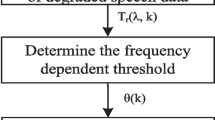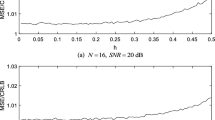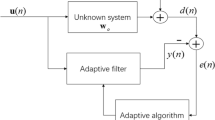Abstract
An interference suppression algorithm is proposed to meet challenges of the traditional technique in dealing with the linear frequency modulation (LFM) interference, such as high loss of signal-to-noise ratio (SNR), the output signal-to-interference-plus-noise ratio (SINR) sensitive to input interference-to-signal ratio (ISR) that results in an unstable synchronization, and the spectrum leakage serious in strong ISR situation. This approach firstly makes use of the windowed and lapped technique to the fractional Fourier transform (FRFT) to enhance the ISR improvement and lower the SNR loss. Then by weakening the interference and a secondary threshold process, interference energy can be suppressed as much as possible and the output SINR is less sensitive to the ISR. Finally, a joint fractional Fourier domain and time domain technique is proposed to overcome the residual interference energy caused by the strong interference or the discontinuous-phase interference. Theoretical analysis and simulation results show that the proposed algorithm can achieve better performance than the conventional methods in suppressing both the multi period LFM interference and the multi chirp-rate LFM interference, especially in the strong interference environment.
Similar content being viewed by others
References
Slilstein L B. Interference rejection techniques in spread spectrum communications. Proc IEEE, 1988, 76(6): 657–671
Tyler S, Amin M. Mitigating interference in direct sequence spread spectrum communication systems. Rome Lab Tech J, 1995, 1: 35–45
Sandberg S D, Del Marco S, Jagler K. Some alternatives in transform-domain suppression of narrow-band interference for signal detection and demodulation. IEEE Trans Comm, 1995, 43: 3025–3036
Kutay M A, Ozaktas H M, Arikan O. Optimal filtering in fractional Fourier domains. IEEE Trans Signal Proc, 1997, 45(5): 1129–1143
Amin M G. Interference mitigation in spread spectrum communication systems using time-frequency distributions. IEEE Trans Signal Proc, 1997, 45(1): 90–101
Barbarossa S, Scaglione A. Adaptive time-varying cancellation of wideband interferences in spread-spectrum communications based on time-frequency distributions. IEEE Trans Signal Proc, 1999, 47(4): 957–965
Chaparro L F, Suleesathira R. Non-stationary jammer excision in spread spectrum communications via discrete evolutionary and Hough transforms. Signal Proc, 2003, 83(5): 1117–1133
Ouyang X, Amin M G. Short-time Fourier transform receiver for nonstationary interference excision in direct sequence spread spectrum communications. IEEE Trans Signal Proc, 2001, 49(4): 851–863
Landry R J R, Mouyon P, Lekaim D. Interference mitigation in spread spectrum systems by wavelet coefficients thresholding. Euro Trans Telecomm, 2008, 9(2): 191–202
Olcay A, G. Faye B. Broadband interference excision in spread spectrum communication systems via fractional Fourier transform. Conference Record of the Thirty-Second Asilomar Conference on Signals, Systems & Computers. Pacific Grove, CA, USA: IEEE Comp Soc, 1998, 1: 832–837
Qi L, Tao R, Zhou S Y, et al. Detection and parameter estimation of multicomponent LFM signal based on the fractional Fourier transform. Sci China Ser E-Inf Sci, 2003, 33(8): 749–759
Medley M J, Saulnier G J, Das P K. Narrow-band interference excision in spread spectrum systems using lapped transforms. IEEE Trans Comm, 1997, 45(11): 1444–1455
Capozza P T, Holland B J, Hopkinson T M. A single-chip narrow-band frequency-domain excisor for a global positioning system (GPS) Receiver. IEEE J Solid-state Cir, 2000, 35(3): 401–411
Almeida L B. The fractional Fourier transform and time-frequency representations. IEEE Trans Signal Proc, 1994, 42(11): 3084–3091
Tao R, Deng B, Wang Y. Research process of the fractional Fourier transform in signal processing. Sci China Ser E-Tech Sci, 2006, 36(2): 113–136
Ozaktas H M, Ankan O, Alper K M. Digital computation of the fractional Fourier transform. IEEE Trans Signal Proc, 1996, 44(9): 2141–2150
Pei S C, Ding J J. Closed-form discrete fractional and affine Fourier transforms. IEEE Trans Signal Proc, 2000, 48(5): 1338–1353
Tao R, Deng B, Wang Y. Research process of the discrete fractional Fourier transform. Sci China Ser E-Tech Sci, 2008, 38(4): 481–503
Zayed A I. A convolution and product theorem for the fractional Fourier transform. IEEE Signal Proc Lett, 1998, 5(4): 101–103
Author information
Authors and Affiliations
Corresponding author
Rights and permissions
About this article
Cite this article
Huang, K., Tao, R., Wu, K. et al. Study on interference suppression based on joint fractional Fourier domain and time domain. Sci. China Technol. Sci. 54, 2674–2686 (2011). https://doi.org/10.1007/s11431-011-4533-7
Received:
Accepted:
Published:
Issue Date:
DOI: https://doi.org/10.1007/s11431-011-4533-7




